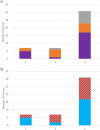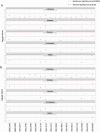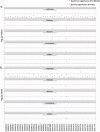Preliminary investigation of potential links between pigmentation variants and opioid analgesic effectiveness in horses during cerebrospinal fluid centesis
- PMID: 38997753
- PMCID: PMC11245827
- DOI: 10.1186/s12917-024-04139-z
Preliminary investigation of potential links between pigmentation variants and opioid analgesic effectiveness in horses during cerebrospinal fluid centesis
Abstract
Background: The pleiotropic effects of the melanocortin system show promise in overcoming limitations associated with large variations in opioid analgesic effectiveness observed in equine practice. Of particular interest is variation in the melanocortin-1-receptor (MC1R) gene, which dictates pigment type expression through its epistatic interaction with the agouti signalling protein (ASIP) gene. MC1R has previously been implicated in opioid efficacy in other species; however, this relationship is yet to be explored in horses. In this study, analgesic effectiveness was scored (1-3) based on noted response to dura penetration during the performance of cerebrospinal fluid centisis after sedation and tested for association with known genetic regions responsible for pigmentation variation in horses.
Results: The chestnut phenotype was statistically significant (P < 0.05) in lowering analgesic effectiveness when compared to the bay base coat colour. The 11bp indel in ASIP known to cause the black base coat colour was not significant (P>0.05); however, six single nucleotide polymorphisms (SNPs) within the genomic region encoding the ASIP gene and one within MC1R were identified as being nominally significant (P<0.05) in association with opioid analgesic effectiveness. This included the location of the known e MC1R variant resulting in the chestnut coat colour.
Conclusions: The current study provides promising evidence for important links between pigmentation genes and opioid effectiveness in horses. The application of an easily identifiable phenotype indicating variable sensitivity presents a promising opportunity for accessible precision medicine in the use of analgesics and warrants further investigation.
Keywords: ASIP; Horse; MC1R; Opioid; Pigmentation; Sensitivity.
© 2024. Crown.
Conflict of interest statement
Rebecca Bellone is affiliated with the UC Davis Veterinary Genetics Laboratory that offers genetic testing in horses and other species, including testing for MC1R.
Figures





Similar articles
-
Synergy between MC1R and ASIP for coat color in horses (Equus caballus)1.J Anim Sci. 2019 Apr 3;97(4):1578-1585. doi: 10.1093/jas/skz071. J Anim Sci. 2019. PMID: 30785190 Free PMC article.
-
The MC1R and ASIP Coat Color Loci May Impact Behavior in the Horse.J Hered. 2016 May;107(3):214-9. doi: 10.1093/jhered/esw007. Epub 2016 Feb 16. J Hered. 2016. PMID: 26884605 Free PMC article.
-
An Independent Locus Upstream of ASIP Controls Variation in the Shade of the Bay Coat Colour in Horses.Genes (Basel). 2020 May 30;11(6):606. doi: 10.3390/genes11060606. Genes (Basel). 2020. PMID: 32486210 Free PMC article.
-
Evolutionary and phylogeographic views on Mc1r and Asip variation in mammals.Genes Genet Syst. 2013;88(3):155-64. doi: 10.1266/ggs.88.155. Genes Genet Syst. 2013. PMID: 24025244 Review.
-
Agouti: from mouse to man, from skin to fat.Pigment Cell Res. 2002 Feb;15(1):10-8. doi: 10.1034/j.1600-0749.2002.00039.x. Pigment Cell Res. 2002. PMID: 11837451 Review.

